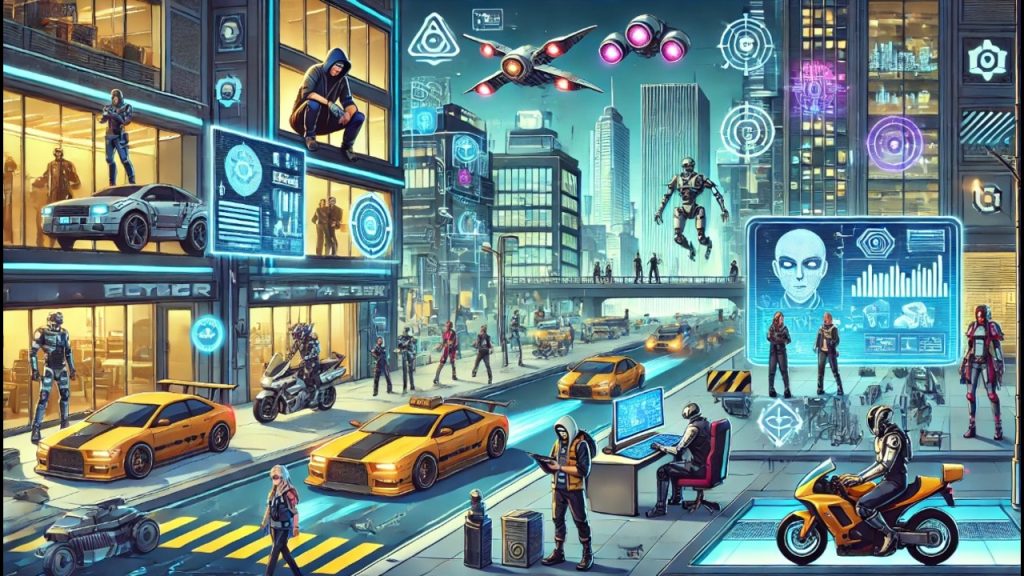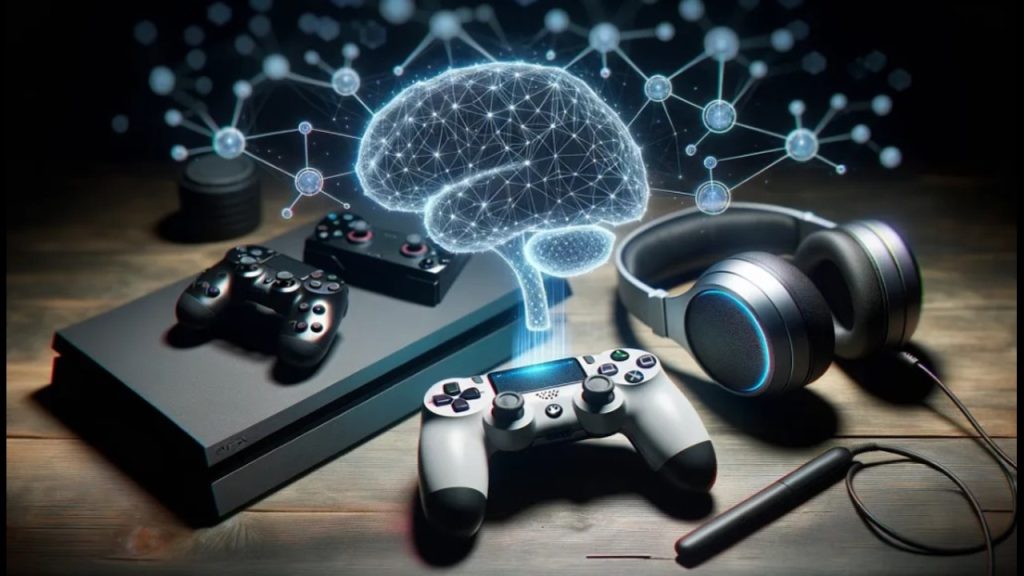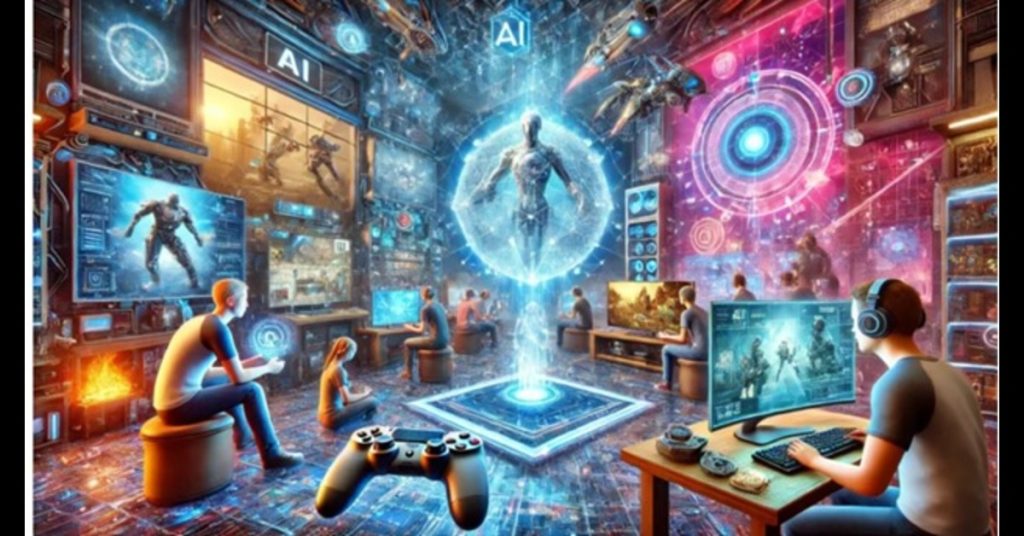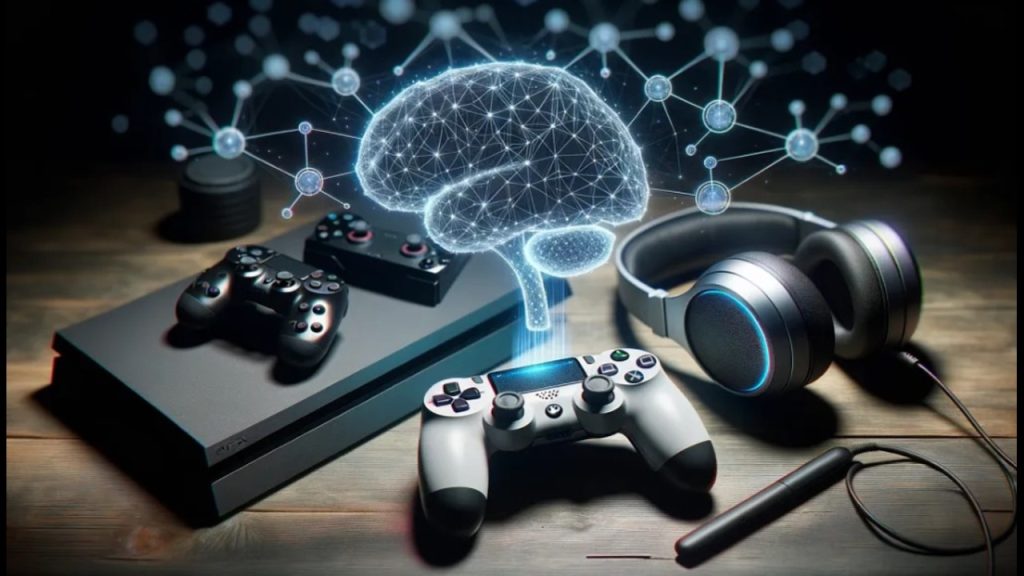
Introduction to AI in Video Games
AI for Video Game Characters has come to stay and become the new foundation of development into modern video games; it has made things very different in the development of characters, stories, and worlds. Initially, non-playable characters (NPCs) were stationary, and now AI has made them dynamic, lively, and emotionally reactive. AI still enjoys a completely new level of realism, engagement, and personalization in real-time dynamic worlds of tomorrow. The very use of AI in game design has made play-enhancing boundaries within interactive entertainment.
Table of Contents
In this fast-changing world, AI for video game characters is important, whether this is through sophisticated voice synthesis, procedural content generation, or adaptive behaviors reacting to player’s actions.
Technology evolves beyond the simple, non-programmable characters into intelligent entities that learn, adapt, and create shared experiences for individual players, which rounds out emotional responses and narratives and, consequently, opens new creative horizons for the industry as a whole.
The AI for Video Game Characters role In character building is nothing but the animation of a character as it comprises voice generation, picture creation, revealing behavior modeling, and even storytelling. These systems go hand in hand to present an experience that is real and engaging.
The article treats several aspects of AI in video game characters, voice technologies, image generators, NPC behaviors, procedural techniques, and future dynamic storytelling-all under the umbrellas of machine learning and adaptive AI concepts.
The Role of AI in Character Development
AI character development is primarily
About implementing believable characters and making a computer game exciting for its users. Therefore, one will have to use complex algorithms with machine learning models to replicate several human attributes such as judgment and decision-making, emotional responses, and social interactions.
With AI, one can build up characters that end up shaping behavior from one person to another; that is, the way of showing reaction will be similar to real-world problems. The world created for these virtual reality experiences becomes more immersive and responsive that way.
AI for Video Game Characters should be about allowing or facilitating customization and making it personal for the characters through which players can shape their avatar or meddle dynamically with NPCs. It will also create guardians, enemies, or allies whose patterns and behaviors change according to the player’s behavior.
Therefore, greater personalization improves engagement and replayability as realistic NPC like behavior with nuanced reactions having believable motivations constitutes such a leap away from mere scripted characters.
In addition, the use of AI for Video Game Characters in visual and audio production to guarantee duplication and diversification through a minimum division of work privately will also be a significant application. Using an AI-powered tool in automatic image generation or voice synthesizer allows for the rapid prototyping and use of characters without lengthy manpower.
All this changes the way characters develop in gaming and, generally, all of game narrative, thus creating more dynamic worlds and deeper emotional resourcing between players and their avatars.
The Evolution from Static to Dynamic Characters
The earliest video game characters were pretty much static: predefined models with a simple script to operate them. But, this paradigm completely changed because of AI. Today’s characters can make their own decisions, respond to stimuli in the environment, and carry on conversations that feel natural and spontaneous.
The recent advances In machine learning, and especially neural networks, that learn from data handed to them with the goal of exhibiting human-like behaviors are the main driving forces behind this evolution.
The characters are dynamic and build a probability model to decide upon actions. Such kinds of responses are unpredictable but at the same time coherent, and they may surprise the player.
The AI for Video Game Characters character might modify its patrol routes according to how a stealth-game player has behaved in the past, making his or her experience tougher and more personalized. Such behavior strongly relies on procedural generation techniques, adaptive AI for Video Game Characters systems, and the ability to feed continuous input and adjust its output in real time.
In addition, this transformation also supports emergent gameplay, commonly regarded as those scenarios that arise spontaneously rather than being explicitly scripted, providing players with an infinite range of interaction possibilities.
The Increasing sophistication of AI for Video Game Characters will soon usher in the day when character development will also involve emotional intelligence, morality systems, and fine-grained social interactions. This indicates how fundamental AI for Video Game Characters is in the near future of interactive storytelling.

Balancing Creativity and Automation in AI-Driven Character Design
In bringing forth the AI-created products at an ever-accelerating power, serious questions arise about creativity and artistic intent in these endeavors. With prior tools now turning into more mainstream automated character design tools, such as using the AI for Video Game Characters image generator and name creator, independent developers and small studios may find themselves empowered through the democratizing effect of these high-quality asset packages. Few clicks, and one is able to generate a number of different characters that are all stunning to behold, thus lessening the barriers to entry in developing games.
However, there exists a debate about when the artists should stop their designs to give the AI for Video Game Characters its own creative cue. Usually, the most engaging characters come from this interaction between human and machine-a design personality and story is inputted and offered in return by the AI- chores such as really tedious character details. It can go two ways: one way could be for AI-generated character concept art, wiled with some design finesse of its own, to form the basis of being forwarded for the in-depth ecology and storytelling treatment.
If a situation occurs, however, wherein automated decision-making processes are selected over a human decision to represent, say, culture, in character creation, then the question of ethics is raised. A developer must have their AI-rendered content respect diversity and not represent stereotypes. Instead, power to create should be viewed within the context of how it complements and extends human creativity.
AI Voice for Video Game Characters
The voice of a character is one of the strongest elements that influence immersion and emotional engagement. AI voice generation technology enables a brand-new way of creating expressive, natural dialogue without the logistics and costs of full voice-over recording.
With such advanced speech synthesis models, developers can create a wide range of voices to express every detail, including deep emotions, accents, and intonations, undoubtedly taking the storytelling experience to another level.

Understanding AI Voice Generation Technology
Deep learning models trained on extensive datasets of human voices are used in AI voice technologies. While these TTS systems analyze different linguistic and prosodic parameters to produce speech corresponding in subtlety to human speech, some pretty recent advances-neural TTS-have been able to produce voices that rival real actors, in terms of flexibility and efficiency. Dialogue production for characters becomes easy.
Text scripts are fed to AI for Video Game Characters models that render the input as audio clips, each able to work with parameter settings for mood or emphasis or context. Some voice-modification systems work in real time, enabling developers to switch voices on the fly. This is a fantastic advantage for interactive characters who need to fit different situations and changing emotions.
Therefore, this technology opens up new chances for localized voiceovers, thereby bringing down translation costs and allowing games to target a worldwide audience. AI-produced voice features can also be tuned to reflect the particular archetype, age group, and culture for any given character, which only adds diversity to the roster of characters.
Applications of AI-Generated Voices in Games
Enhancing Player Immersion Through Dynamic Dialogue
Dynamic dialogue powered by AI voice technology is a game-changer for player immersion. When NPCs can speak naturally, empathize, and react spontaneously, players develop stronger emotional bonds with characters. This realism encourages deeper engagement, fostering a sense of living, breathing worlds.
One approach is integrating AI voice capabilities with NPC behavior systems, allowing characters to adapt their tone and word choice based on the player’s actions or story developments. Such responsiveness makes dialogues feel organic rather than pre-scripted, elevating narrative depth.
Real-time anger and joy or even sadness can be expressed in AI voices, apparently in response to playing events or players? Decisions. The emotional authenticity thus renders the storytelling to have more layers and the choices more meaningful. These technologies are developing, and probably, further nuanced and more personalized actions will be developed for even more assimilation of player and player character.
AI Video Game Character Creation
Creating compelling characters is at the heart of engaging gameplay. AI-powered tools streamline this process by providing rapid, customizable options for visual design, personality traits, and backstories. The rise of AI for Video Game Characters image generators and character creation platforms democratizes character development, enabling developers and players alike to craft unique identities effortlessly.
AI Image Generators for Character Design
AI for Video Game Characters image generators employ generative adversarial networks (GANs) or diffusion models to render ultra-high-quality images based on textual prompts or style references. Such means of generating diverse character appearances can transit from fantasy warrior archetypes to futuristically styled cyborgs almost instantaneously and without any perceived cost.
Artists and developers would offer descriptive keywords, letting the AI for Video Game Characters give multiple visual options for rapid iteration and inspiration. This hastens the timeline of a project as it cuts down on reliance on traditional graphics design methods and expands opportunities for creative expression. Also, the artwork generated from AI for Video Game Characters can go through fine-tuning and combination with manual work to achieve the intended aesthetic.
Such tools also allow indie developers with smaller resource pools to produce characters that are visually appealing in a competitive market. Adding to this is the fact that AI for Video Game Characters art of video game characters also permits the exploration of new innovative pathways that traverse stylistic boundaries and hybrid genres, all of which will nourish the visual language of gaming.
Customization Tools: From Concepts to Real Characters
There are occasions when character creation is needed for the sake of player agency and identity expression. AI-enabled customization tools that assess user choices regarding facial features, attire, or accessories produce meaningful and wearable character models. Often, these systems provide straightforward controls that let the player manipulate various parameters at will.
AI filters could allow developers to weave in sophisticated options for customization without burdening the user with extreme complexity. Suddenly, an AI for Video Game Characters face modifier enters the scene, allowing expression and age changes to deepen the illusion of realism. Matching outfits, hairstyles, and color schemes can also be generated by the tool to speed up the customization process.
At the same time, AI customizations bring more socialization into multiplayer and community-driven games and engender a sense of ownership. It also empowers game producers to offer varied default looks so that inclusivity and representation apply. As technology AI for Video Game Characters becomes more prevalent, customization will move even further into the realm of smoothness and expression.
Free AI Character Generators and Their Impact on Indie Developers
The era of free AI character generator tools has given access to even small teams and independent artists to create their own quality assets without burning a hole in their pockets. Such platforms that provide character image and model generation free and freemium facilitate faster prototyping and real-time testing of character concepts.
With such widespread availability to use for indie projects, this encourages experimentation with styles, shaders, and genres that may have become financially burdensome in earlier times. Developers can build prototype assets quickly, refine ideas, and encourage community co-creation in an accelerated manner.
However, limitations also come with free tools in terms of copyright issues, inconsistent quality, and inability to heavily customize. Nonetheless, they have been more favorable in development toward a more creative and eclectic indie scene where such tools promote ingenious resourcefulness that injects new ideas and designs into the gaming ecosystem.
Advanced AI Features in Character Interaction
Interactivity with intelligent in-game characters is a precondition for an immersive experience game. In connection with the non-playable character behavior model, developers can use machine learning to empower NPCs with subtlety in social dynamics, emotional reactions, and adaptive strategies. These features make the game world feel alive and responsive, thus heightening emotional investment.
NPC Behavior Modelling with Machine Learning
Models of NPC behavior are generated using machine-learning algorithms to represent complex decision trees and methods of social interaction. In contradistinction to implemented behaviors, ML-based NPCs are ever-evolving, learning from the actions of players, environmental stimuli, or even specific internal state variables to simulate unpredictable, realistic reactions.
For instance, an NPC guard might change patrol routes according to recent activity of the character, while a shopkeeper would vary their dialogue according to the player’s In-game reputation. Such behavior creates emergent situations that take the player by surprise and challenge them, reinforcing the feeling of agency within the game universe.
Therefore, a developer trains models via datasets of human behavior so that NPCs can produce social cues such as hesitation, confidence, or suspicion. This way of creating characters results in one that exhibits genuine situationally adequate responses, increasing the game’s immersion and narrative depth.
Adaptive AI – Tailoring Experiences Based on Player Actions
Adaptive AI for Video Game Characters has brought behavior modeling really one step ahead by customizing gameplay experiences in real-time. Considering the player’s tactics, preferences, and emotional condition, it dynamically alters the levels of difficulty, storylines, and character interactions.
For example, say there’s a player who has trouble with combat-the AI for Video Game Characters might change enemy strategies to give that player the right amount of challenge. Suppose he’s a player who enjoys exploring-the game may then reveal treasure hunts that are not included in quests or the discovery of lore. That is a change that keeps the player engaged and will make them not frustrated or bored.
Otherwise, adaptive AI for Video Game Characters needs a deep collection and analysis of data, which is mostly using a reinforcement learning technique. It aims at ensuring that the player feels as though the game has been modified to smoothly correspond to him/her, thus developing interest and bonding for the long term.
Creating Emotional Responses in Non-Playable Characters
The fictional world becomes even more deified as emotional responses enhance the story by making it seem alive through the characters. The latest advancement in affective computing gives AI for Video Game Characters systems the capability to understand emotionally simulated state and their eliciting response whenever the player evokes it by action or perception of the narrative context. NPCs will emotionally vary, for instance: happiness after a successful quest or anger when the NPC feels betrayal, thus forming relationships that evolve like human social dynamics. This feature may affect gameplay-such as trust, alliances, or rivalries-so it becomes even more natural.
The integration of emotion simulation will thus involve multi-modal data input, including speech tone, facial expressions, and contextual clues. Such characters tie into promoting empathy and attachment that with the game soon be translated into a profound experience for players richly filled and resonant with emotion.
Procedural Generation and Dynamic Storytelling
Procedural generation uses algorithms that create content—levels, items, narratives—that are unique every playthrough. With AI, this technology offers infinite stories, giving players personalized journeys that feel handcrafted but are generated on-demand.
The Intersection of Procedural Generation and AI
Procedural generation, until now, depended on a rules-based mechanism; combining the likes of AI for Video Game Characters serves to enhance diversity and coherence. Such models may learn from existing narratives, styles, and player preferences to generate content that aligns in tone or theme and difficulty curve.
AI for Video Game Characters becomes capable of designing landscapes, quests, or conversations appropriate to a certain genre or mood. Such approaches allow for an adaptive output based on learned datasets from existing successful games, giving the right blend of novelty and familiarity.
It Is this balance that allows developers to vertically scale the content creation process minus the workload growing exponentially. It also promotes the idea of personalization, where system-generated storylines might change according to player choice or emergent gameplay, ensuring the continued interest of the player for a long time.
Crafting Unique Stories Through AI-Driven Narratives
The narratives that AI for Video Game Characters can develop move in and out of linearity as they create dynamically branching plot paths, character development, and plot turns within themselves. By integrating NLP with machine learning, these games can formulate conversations, background lore, and conflicts catered to specific players.
The storyline can often change based on the personality trait of the player, choices in the game, or emotional reactions. An
players a sense of vested interest-wanting to see their actions manifest meaningfully within the unfolding narrative. It also results in maximum replayability since no two experiences are the same, a feature of progressive game design.
The Future of Dynamic Storytelling in Video Games
Dynamic AI-based storytelling, therefore, will disrupt narrative design for which now has all sorts of neural models, emotion models, and contextual understanding drivers. These characters will develop gifts in the creation of very personalized, emotionally resonant stories under the parameters of real-time adaptation. Against this backdrop, the game world can engage interactions with an element of truth as AI for Video Game characters could remember what was said and evolve in relationships. The worlds themselves may be reconfigured in line with narrative-driven needs, crafting believable yet immersive universe experiences.
The outcome will offer the interspace between interactive movies and games, experiences just as emotionally potent as technically sophisticated. As AI for Video Game Characters evolves, thus too will a huge scope for artistic expression and the complexity of storytelling, giving birth to the next generation of interactive entertainment.
Character Customization and Realistic Animations
Indeed, true-to-life customization and animations of a character will enable immersion for a player. AI-based mechanisms offer the possibility to accomplish extremely detailed personalization and realistic motions, thus enabling the character to become believable and emotionally engaging. Such innovation ensures players can see themselves in the game world and relate more to narrative elements.
Innovations in Character Customization through AI
It goes beyond sliders and presets, which is the old-fashioned method, and gives the players more detailed options to customize character features such as facial structures or body types, clothing, and accessories. With the help of deep learning, the models understand user inputs and generate changes that fit perfectly in the artistic style of the game.
Systems like these might offer different variations in modifying based on personality traits, aspects of the narrative, or even cultural things that can further enhance the inclusion that would be offered. Besides, because of AI for Video Game Character, the possibility of creating avatars at a much faster pace has become quite real since it removes the long process of tedious adjustment. That means players can make avatars that truly echo their personal identities.
In multiplayer scenarios, customization made more powerful by AI for Video Game Characters creates greater social cohesion, as players can now confidently express individuality. In due course, these tools would tap into biometric data or emotional states for an even more seamless level of personalization and immersion.
Realistic Animation Techniques Enabled by AI
Realism in animation relies on the precise capture of natural habits, contortions, and gestures. AI for Video Game Character tools, such as motion capture data interpolation, pose estimation based on deep learning, and physics simulation, generate higher-fidelity character motions.
For instance, AI for Video Game Characters would be able to intersperse cycles of walking and running seamlessly or animate facial Tweens in real-time, depending on narrative cues.
Deep neural networks trained on extensive motion datasets provide rich contextual animation that responds to external interactions and emotional states.
These developments, therefore, lessen the load on the poor animators, saving time and resources. They also allow characters to convincingly realize salient actions for imposing the trustfulness of the prescribed scenario and the accompanying emotional weight, both of which are pivotal in storytelling and player investment.
The Importance of Believable Characters in Player Engagement
From character design all the way to animation, believability directly infers the players’ perceptions and interactions with the game world. Real, believable characters prompt empathy, interest, and emotional impact, some of the primary contributors to retention and delight.
Therefore, all unconscious, AI for Video Game Character-directed algorithms guarantee that when the characters obey the rules of the narrative, acting both visually and aesthetically, it keeps an atmosphere of believability. When players see these believable reactions, expressions, and movements, they have a stronger feeling of immersion, with the game world suddenly becoming something that is felt, lived, and experienced.
In addition, number-one realistic characters can advance cultural portrayals, societal representation, and tricky personalities, thereby enriching the storytelling experience and increasing mass appeal. And as AI for Video Game Characters keeps on going, those demarcations between the human and nonhuman would keep on shrinking, bringing in a new age of emotive and believable virtual beings.
Enhancing Player Interaction with AI
Interactivity between players is central to game play, and AI for Video Game Characters enhances the process by creating environments that respond to the player’s actions, characters that exhibit emotional intelligence, and feedback systems that adapt to individual players. All of these systems promote a sense of agency, heighten emotional involvement, and customize the experience.
Player Feedback Loops and Responsive Game Environments
Responsive environments utilize AI for Video Game Character to alter the terrain, difficulty, and resource distribution taking into consideration player performance and behavior. The feedback loops continuously change the game state to pose a customized challenge, one that would be engaging, not frustrating.
For instance, suppose the player is good at combat. In that case, the AI for Video Game Character may choose to ramp up the difficulty by presenting either tougher enemies or convoluted puzzles. On the contrary, should the player be exploring, the environment may reveal hidden spots or stories rich in lore. This responsiveness ensures that the game captures continuous interest while promoting experimentation.
Such an adaptive system relies on real-time tracking of player behavior, learning models to predict player needs, and implementation in-game mechanics-so it makes the game feel like it’s gone from static to life, organic interactions.
Emotional Intelligence in AI Characters
Instilling emotional intelligence in theAI for Video Game character evolves their role from an obstacle or quest-giver into believable, personable entities that bond, empathize, and react emotionally. The depth of these relationships creates a more profound story and invests players emotionally into it.
Having characters that can currently read the player’s cues, like tone of voice or facial expressions, and respond (such as showing concern for distress or cheerful enthusiasm for success) makes the whole interaction seem really authentic.
This emotional give-and-take makes players want to form emotional bonds with the character and then hopefully grow with that character to see where it goes over time.AI for Video Game Character could be evolved with time by remembering their interactions in past memories and changing their actions accordingly, giving a more satisfying experience.
Strategies for Improving Player Relationships with Characters
In order for the building of true relationships between characters and players to take place, consistency, flexibility and authenticity must be kept alive.AI for Video Game Character can do this through traceable and remembered past interactions, through evolving personalities as well as contextual responses.
The first approach could be making use of natural language processing-enabled dialogues that allowed real communicating with NPCs. Adding to the emotional responses, that is when play achieves actual social communion.
Another concern would be having characters in profiles of deep personality- beliefs, prejudices, and motivations which shift with player choices- just like human relationships. This is complexity enough to get players thinking about their actions for characters.
Ultimately the innovation toward using AI for Video Game Character to appreciate subtle emotional interactions will redefine the way a player engages with a virtual world, thus personalizing gaming to a greater extent.
Conclusion
The integration of artificial intelligence in game development heralds a new age in interactive entertainment for characters. Synthesizing voice and image, approximating activity, and telling stories dynamically through the intervention of artificial intelligence help developers create worlds inhabited by believable, emotionally resonant characters. These innovations enhance production approaches and accentuate immersion, intimacy, and personalization, making them something untouchable in the previous eras of gaming technology.
Future games hold great promise as machine learning, procedural generation, and emotional intelligence grow and converge into worlds where characters react, develop, and evolve side by side with players: truly unforgettable journeys in digital marketing realms.
The application of artificial intelligence in the character creation process in computer games brings a whole new dimension into the game of interactive entertainment. From voice synthesis and image generation to behaviors that adapt and dynamically change storytelling, artificial intelligence empowers developers to design worlds filled with credible, lifelike characters who offer real emotional responses. These innovations make it possible to easily achieve impossible production things and enhance user immersion, relationship development, and personalized experience to a level never seen before.

As machine learning, procedural generation, and emotional intelligence continue to grow, the future of games is set to promise worlds where characters respond, grow, and evolve with the player-created experiences truly unforgettably digital.
FAQS
What is AI funny?
An AI character in video game terms is a non-player character (NPC) that has certain independence in its behavior in a sensed and felt existence, making decisions actively based on programming algorithms rather than using a pre-scripted action list; they adapt to player behavior, learn from their behavior, and thereby present an enjoyable gaming experience for the players.
How does AI improve video-game characters?
AI enhances video game characters by:
– Reacting realistically to player actions (e.g., enemies changing their tactics).
– Allowing for stories to change on the fly (e.g., when NPCs remember things from previous encounters).
– Further contributing to immersion through lifelike movements, emotions, and judgment .
Who are some iconic AI characters in gaming?
Some AI characters we would call iconic are as follows:
– GLaDOS (*Portal*) – An evil AI characterized by its dark wit.
– Cortana (*Halo*) – An AI companion .
– SHODAN (*System Shock*) – A truly evil AI.
– EDI (*Mass Effect*) – An AI that matured into a sentient individual .
What are major tools for creating AI game characters?
These tools include a wide range of technologies:
– Game Engine: Unity, Unreal Engine, etc. The latter has some in-built AI mechanisms such as NavMesh.
-AI Middleware: RAIN, xAIToolkit.
– Machine Learning: TensorFlow, PyTorch for adaptive AI .
Do AI characters learn from the players?
Yes! Advanced AI uses methods such as reinforcement learning to adapt:
– In Elden Ring, enemies study their player’s pattern.
– NPCs in *The Last of Us Part II* change their action dynamically based on the player’s action .
How do game characters use AI voice generators to create character voices?
AI voice tools like MagicVox and Voicemod rely on:
– Neural networks to imitate human speech.
– Text-to-speech (TTS) technology for dialogue that can change dynamically.
– Real-time voice adjustment for NPCs’ interaction .
What would the future of AI in character evolving be?
Future trends include:
– Generative AI (like Nvidia’s Body Motion for animations).
– AI companions that show emotion(like *Sons of the Forest*).
– Procedural storytelling, in which NPCs dictate the story based on the player’s decisions .
Cite a brief summary on AI enemies vs. in-game scripted enemies.
– Scripted enemies are bound to fixed movement patterns (such as the *Pac-Man* ghosts).
– There is a measure of intelligence in how AI enemies (like *Warzone 2.0*) possess pathfinding, flanking, and adaptive tactics on whom to gun for .
Is AI taking over human work as a game writer and animator?
Partially indeed. AI tools do speed up the animation process, like with Nvidia’s Body Motion, but a human being is still crucial at the *storytelling* and *fine-tuning* processes .
What are the biggest problems in developing AI characters in games?
Key problems:
– **Realism vs. Fun** (very smart AI can become frustrating for players).
– **”Artificial-Stupidity-Avoidance (e.g. NPCs stuck in the wall).

